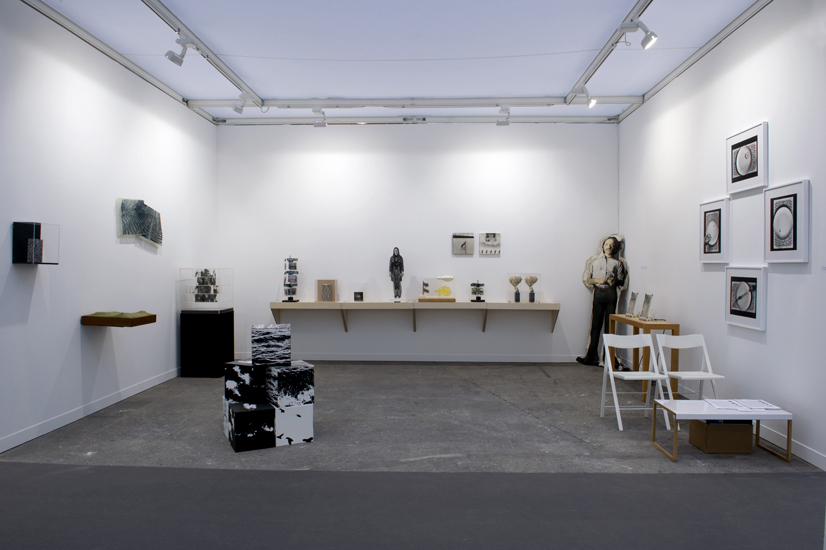Press Release
At Paris Photo, Cherry and Martin will exhibit photographic objects associated with curator Peter Bunnell's 1970 landmark exhibition, "Photography into Sculpture." These objects have never been seen in Europe.
"Photography into Sculpture" was the largest and most widely seen exhibition of new photographic objects to appear in the late 1960s and early 1970s. Described in the original wall text as "the first comprehensive survey of photographically formed images used in a sculptural or fully dimensional manner," the show opened at the Museum of Modern Art in New York in April 1970 and traveled to eight museums in the US and Canada. "Photography into Sculpture" encapsulated the radical gestures of late 1960's photography, both inside and outside the photo world. "Photography into Sculpture" tied together threads from previous exhibitions, introduced new ideas and set the stage for future shows like curator John Szarkowski's 1978 MOMA exhibition, "Mirrors and Windows," which included several of the same artists.
The 23 artists included in "Photography into Sculpture" responded to the changing role of the photographic image and related technologies in modern life. In his essay Peter Bunnell writes, “For while photography has been one of the most unsettling forces of the last hundred years, its assimilation into common experience has been so complete, and its evolution so progressive, that for most persons the medium hardly exists on a conscious level.” Historian Mary Statzer has pointed out that the dates of "Photography into Sculpture" at MOMA nearly overlap with those of curator Kynaston McShine's 1970 exhibition, "Information." Bunnell has described discussing photographic objects and practices with McShine--the book works of Ed Ruscha, for example, or those of Ingrid and Iain Baxter's N.E. Thing Co.--as part of a loose, ongoing conversation they were having as to where these objects and ideas 'fit' within photography and the newly evolving thread of conceptual art.
It was Iain Baxter, in fact, one of the artists included in McShine's "Information," who introduced Peter Bunnell to the other members of the "The Intermedia Society," a Vancouver experimental artist's workshop with which Baxter associated. Bunnell was intrigued by Jack Dale's constructions made from photosensitized glass and Plexiglas ("Cubed Woman #3 a-b," 1970), as well as Michael de Courcy's stacked cardboard boxes ("Untitled," 1970). Photographed in various urban and rural locations across Canada, de Courcy's stacked image boxes later appeared on the cover of Artscanada's June 1970 coverage of "Photography into Sculpture." On that same trip, Los Angeles-based artist Robert Heinecken ("Figure Foliage," 1966) introduced Bunnell to current and former UCLA students Ellen Brooks, Carl Cheng, Darryl Curran and Michael Stone. One of the few women in Bunnell's show, Ellen Brooks ("Flats: One Through Five," 1969) experienced controversy for her works depicting sexuality; Carl Cheng's film, molded plastic and Plexiglas pieces ("Sculpture for Stereo Viewers," 1968) were a precursor to his activities under the name of John Doe, Co.
Robert Heinecken's own work was already well known in photo circles having appeared in Bunnell's 1968 MOMA exhibition, "Photography as Printmaking," which like "Photography into Sculpture," included artists previously seen in exhibitions organized by Nathan Lyons: "The Persistence of Vision" (George Eastman House, 1967) and "Vision and Expression" (George Eastman House, 1969.) Bunnell also included Los Angeles-based artist Robert Brown, his San Francisco-based collaborator James Pennuto ("Tracks," 1970), and Jerry McMillan ("Wrinkle Bag," 1965), whose idiosyncratic photographic practice had evolved outside of photo world. McMillian's 1966 solo exhibition at the Pasadena Art Museum was curated by Walter Hopps, one of the founders of Ferus; McMillian's immediate peers were painter and sculptor friends like Ed Rushca and Joe Goode, who like him, had come to Los Angeles from Oklahoma City in the late 1950s.
It was young LA artist Richard Jackson ("Negative Numbers," 1970-2011) who made the work that was the most prescient for Bunnell in terms of the changes to come in photography. In a visit to Jackson's studio, the young curator noticed that Jackson wasn't printing his negatives at all--he was using them to make sculptural objects--which flabbergasted him: “It had never been suggested to me that one did not make prints from photographic negatives, even though I recognized that the negative was the basically most ‘photographic’ of objects." To this heady mix of West Coast artists, Peter Bunnell added the New York-based Fluxus figure Robert Watts, whose experiments with photographic verisimilitude had been shown in New York at Castelli Gallery in 1964 and written about by Donald Judd; younger East Coast-based artists Douglas Prince, Ted Victoria, and Lynton Wells ("Untitled," 1969); Dale Quarterman from Chicago ("Marvella,"1969); and Bea Nettles from Champaign, Illinois.
The full artist list was: Ellen Brooks, Robert Brown, Carl Cheng, Darryl Curran, Jack Dale, Michael de Courcy, Karl Folsom, Andre Haluska, Robert Heinecken, Richard Jackson, Jerry McMillan, Bea Nettles, Ed O'Connell, James Pennuto, Joe Pirone, Douglas Prince, Dale Quarterman, Charles Roitz, Leslie Snyder, Michael Stone, Ted Victoria, Robert Watts, and Lynton Wells. Cherry and Martin has located all of the original artists except Karl Folsom, Ed OʼConnell, and Leslie Snyder. Any information as to their whereabouts would be deeply appreciated, as the gallery has thus far been unable to find these three artists. "Photography into Sculpture" opened at the Museum of Modern Art (New York, NY) in 1970 and over the course of the next two years traveled to Krannert Art Museum (Champaign, IL); Menil Collection (Houston, TX); Fort Worth Museum of Modern Art (Fort Worth, TX); Vancouver Art Gallery (Vancouver, BC); Virginia Museum of Fine Arts (Richmond, VA); Phoenix Art Museum (Phoenix, AZ); San Francisco Museum of Modern Art (San Francisco, CA); and Otis College of Art and Design (Los Angeles, CA).
(Cherry and Martin archive)
Philip Martin gallery hours are Tuesday through Saturday from 11am-6pm and by appointment. For further information and images please contact the gallery at +310-559-0100 or info@philipmartingallery.com.
Philip Martin Gallery
2712 S. La Cienega Blvd.
Los Angeles, CA 90034
+310-559-0100
info@philipmartingallery.com
